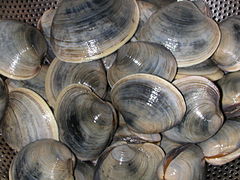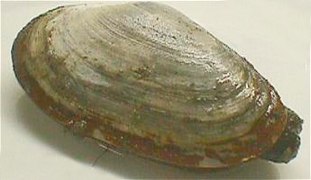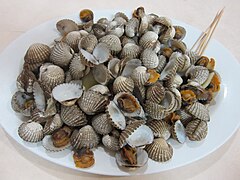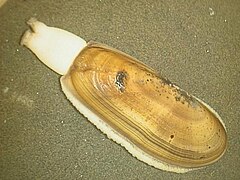Cookbook:Clam
| Clam | |
|---|---|
 | |
| Category | Shellfish |
Cookbook | Recipes | Ingredients | Equipment | Techniques | Cookbook Disambiguation Pages | Ingredients | Seafood | Shellfish
Clams are are group of hinged shellfish.[1]
Varieties
[edit | edit source]There are many varieties of clam distributed worldwide,[2] and the available varieties will depend on what lives locally.
Hard-shell/Quahog
[edit | edit source]These clams are found on the east coast of North America and go by many names depending on their size.[1] The smallest are littlenecks, followed by topnecks, cherrystones, and chowders.[3][4] The flesh is white and mildly briny.[1]
Surf
[edit | edit source]Also found in the Atlantic, these are yellow- to orange-fleshed clams.[4] They tend to be chewier, and frying (e.g as clam strips) is a good option.[1][4] They also tend to be processed for sale and are available canned.[5]
Soft-shell
[edit | edit source]These Atlantic clams have brittle shells and never close completely. The flesh is tender, which makes them commonly consumed steamed.[4][6]
Atlantic razor/jackknife
[edit | edit source]Atlantic razor or jackknife clams are long, thin, rectangular clams. The flesh is cream-colored and somewhat tough but flavorful, and they are often steamed.[1]
Pacific razor
[edit | edit source]Somewhat wider and thicker than the Atlantic variety, these clams have white flesh and a delicate flavor.[4]
Cockle
[edit | edit source]Though not technically clams, cockles look extremely similar and have a distribution across continents. They are treated pretty much the same as clams in most respects.[6]
Manila/Asari
[edit | edit source]Manila clams are very popular in East Asia and the Pacific coast of North America, where they are commonly found. The shells are ridged, and they have a sweeter flavor compared to some other clam varieties.[4][7]
Geoduck
[edit | edit source]Geoduck clams are very large, with long, wrinkled siphons, and they also do not close completely. The meat is tender and is often sliced thin and eaten raw.[4]
-
Manila clams
-
Quahog clams
-
Soft-shell clam
-
Cockles
-
Geoduck clam
-
Pacific razor clam
-
Atlantic razor clams
Selection and storage
[edit | edit source]Since clams tend to accumulate toxins, it's best to either purchase from a reputable vendor or to gather them in locations designated as safe by the authorities.[1]
When selecting whole clams, make sure to choose live ones. For hard-shell clams, the shells should be tightly closed or should close when you disturb them.[2][8] For varieties of clam that never close completely, the tongue/siphon should move when disturbed.[9] Clams that float in water are also dead.[9] Discard and do not cook any dead clams. Live clams in their shells can be stored in the fridge for a day or two if kept in a damp towel or cloth bag.[9] Never store them submerged or in a sealed container, as they will suffocate.[1][9]
Shucked clams are also available, and they should smell fresh with no off ammonia or fishy odors.[6] The meat should be plump and moist, with clear juices and no shell fragments.[9] Store these in the fridge for up to a couple days. They can also be frozen in brine for a few months but can never be refrozen after thaw.[9]
Cooked clam meat can be stored in the fridge, but it should not be frozen since this tends to give it a very tough texture.[9]
Preparation
[edit | edit source]Because clams tend to accumulate sand and other grit inside their shells, it's generally a good idea to purge whole clams before cooking.[2][10] To do this, submerge them in a gallon of water with ⅓ cup dissolved salt to mimic seawater for 30–60 minutes.[10] Leave them undisturbed—they are sensitive to vibration—and they'll start to filter the water and eject their sand. Don't leave them submerged for longer than that without changing the water, since they'll use up the oxygen and suffocate.[10]
If you are shucking hard-shell clams, freezing them for 15–20 minutes before letting them sit for a couple minutes at room temperature will help to relax their muscles. This will make it easier to insert a clam knife and twist the shell open.[10][11] Make sure to reserve the flavorful clam juice when shucking if you want to use it in cooking.[11]
Use
[edit | edit source]Clams are eaten worldwide and prepared in a variety of different ways. Some tender varieties may be eaten raw, either right out of their shells or as sashimi.[8] When cooked in the shell, some varieties may be grilled, steamed, or tossed directly into soups/sauces—in these cases, the shells must be plucked from the dish and discarded. Shucked clam meat can also be cooked and incorporated into a variety of dishes. Fried and stuffed clams are eaten in the United States, along with clam chowder.[2][6] Pasta alla vongole is an Italian dish of clams and pasta.
Overcooking clams will make the flesh tough and unappetizing.[6][11] Ideally, cooking them quickly or over low heat is best. When cooking whole hard-shell clams, a good indicator of doneness is when the shell open up.[6]
Recipes
[edit | edit source]References
[edit | edit source]- ↑ a b c d e f g America, Culinary Institute of; Ainsworth, Mark (2009-02-04). Kitchen Pro Series: Guide to Fish and Seafood Identification, Fabrication and Utilization. Cengage Learning. ISBN 978-1-4354-0036-8.
- ↑ a b c d "A Guide to Clam Types and What to Do With Them". Serious Eats. Retrieved 2024-04-07.
- ↑ "All About Clams: From Littlenecks to Steamers". The Spruce Eats. Retrieved 2024-04-07.
- ↑ a b c d e f g Labensky, Sarah R.; Hause, Alan M.; Martel, Priscilla (2018-01-18). On Cooking: A Textbook of Culinary Fundamentals. Pearson. ISBN 978-0-13-444190-0.
- ↑ "Clam, Surf | SeafoodSource". www.seafoodsource.com. Retrieved 2024-04-07.
- ↑ a b c d e f Gisslen, Wayne (2014-04-15). Professional Cooking. Wiley. ISBN 978-1-118-63672-5.
- ↑ "What to Know About Cooking With Manila Clams". The Spruce Eats. Retrieved 2024-04-07.
- ↑ a b The Culinary Institute of America (CIA) (2012-04-16). Garde Manger: The Art and Craft of the Cold Kitchen. John Wiley & Sons. ISBN 978-0-470-58780-5.
- ↑ a b c d e f g "How to Best Select and Store Clams". The Spruce Eats. Retrieved 2024-04-07.
- ↑ a b c d Wolke, Robert L.; Parrish, Marlene (2002). What Einstein Told His Cook: Kitchen Science Explained. W. W. Norton & Company. ISBN 978-0-393-01183-8.
- ↑ a b c "Tips for Cooking Fresh Clams". The Spruce Eats. Retrieved 2024-04-07.






